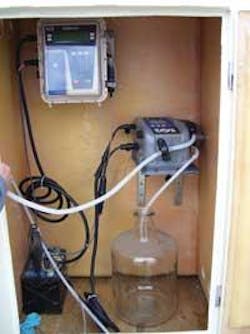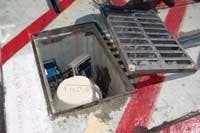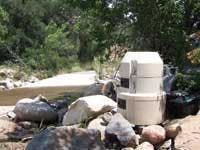Stormwater Monitoring: Smart Stations Provide Multiple Sampling Options
By Rachel Schneider
Advances in sampling methods and control instrumentation are helping optimize monitoring and improve modeling for stormwater management
Regulatory agencies are imposing increasingly stringent requirements for managing stormwater runoff-from urban construction and suburban developments to agricultural tracts that require monitoring facilities in remote or newly-developing areas. There are distinct advantages to good stormwater management: improved flood prevention measures, preservation and expansion of healthy wetlands, and increased public awareness of each community’s role in mitigating the effects of stormwater runoff.
Advances in stormwater sampling methods and instrumentation have opened the door to new best management practices (BMP) that not only provide a clearer picture of stormwater runoff characteristics, but enhance responsiveness to fast-moving storm conditions. Remote sampling has become a widely adopted method to optimize management practices and reduce the frequency of onsite visits.
With so many variables in site conditions and local regulations, communities and water management contractors must constantly evaluate new monitoring and sampling technologies for their ability to deliver accurate and comprehensive sampling methods.
Sean Porter, a senior scientist for an Atlanta-based firm specializing in environmental and remedial engineering, is heavily involved in all aspects of stormwater monitoring. Porter designs, installs, and supervises the monitoring sites and provides the field crews for Department of Transportation (DOT) and other research institutions. The DOT project was initiated to determine water quality from roadways, Park and Rides, and transportation maintenance facilities.
These monitoring operations provide scientific answers about what is being discharged and at what flow rates. This allows state and local agencies to run watershed models based on land use and amount of rainfall. As a result, they can more accurately calculate yearly loadings from different parts of the watershed and select the BMPs most likely to reduce and/or clean up the pollutants specific to each area.
The progression and advances in monitoring technologies and methods has been swift, Porter said.
“Before the advent of automated monitoring equipment, a technician went to the specified area, physically filled up a sample bottle, took water depth measurements and then timed the flow rate by filling up a five-gallon bucket or by performing a Manning calculation.”
Porter said the next step, beginning around 1999, was combining time-weighted composites with flow-rate data acquired from velocity probes and similar equipment. The composites were then weighted toward the higher flows, allowing personnel to determine the event mean concentration.
“The emphasis now is on loadings,” said Porter. “Since we have instrumentation that can automatically provide flow data and a composite sample weighted towards the higher flows, we can come up with a loading. For example, now we can know exactly how many pounds or kilograms of copper or lead or mercury entered the receiving water for a given storm event. If the storm event caused two inches of rain, then we can extrapolate loadings for one inch of rain, and so on.”
Equipped for All Sampling Methods
Porter’s firm provides monitoring at more than 50 stations throughout southern California. “A monitoring station for us typically includes a Sigma 950 Bubbler Area Velocity Flowmeter, either a Sigma 900 Max or a new SD900 Sampler Controller, and a Sigma 1000 telemetry system. One of the reasons we have chosen this equipment is for its plug-and-play features,” he said. “It’s like Legos-you can put them together in any combination you want and the operation is seamless. All the different components communicate with each other and the output format for the data set to be collected is easy to manipulate and present.”
Ease-of-Use Imperative
Stormwater sampling in southern California is highly seasonal. May through September is typically very dry, but October through April is the rainy season and an extremely busy time for sampling personnel.
The Chief Scientist describes a typical scenario for collecting multiple bottle time-weighted samples: “We can program the sampler to pull the first sample into a bottle at 8:00 am, then have it wait one hour before pulling a sample into the next bottle. Instead of having field crews sit out there every hour and fill up jars, the auto sampler does it for us.”
He added that technicians simply harvest the sample bottles from each autosampler at the end of the cycle, replacing them with clean bottles for the next sampling period. Using the same autosampler, the field operator can also collect a time-weighted composite by fitting the sampler with a single bottle, then programming it to collect the required aliquot samples at specified intervals.
In flow-weighted composite sampling, the timing of the aliquots is based on the flow rate.
“Therefore, the sampler must be connected to a flowmeter with pacing ability (e.g., the collection timing can be adjusted to the volume of flow), such as the Sigma 950. If the flow rate is 10 gallons per minute, a 100 mL aliquot would be collected at the end of 10 minutes,” he said. “As the flow rate increases, the sampling intervals also increase, and vice versa. A single bottle filled by the flow-weighted composite method provides a sample that is weighted toward the higher flows, since more aliquots are collected during the higher flows.”
For flow-weighted composite sampling, Porter typically programs the automatic sampler controller to send the sample history to the flowmeter, which records it, and it can then be downloaded with the flow and rain data.
“The information can be used to create a hydrograph that shows when the sampling points occurred. The sample history is actually stored both in the flowmeter and the sampler. If there’s a problem with the flowmeter’s data, then we can always refer back to the auto sampler and download it.”
In Control
New technology and instrumentation have improved the ability to monitor water quality continuously regardless of weather and accessibility. The monitoring stations overseen by Porter and his staff can be monitored and programmed from other locations, saving the cost of trips to the field and reducing the risk of accidents. Advanced control instrumentation provides sampling personnel with complete control over the unit sampler, which makes site monitoring much easier from remote locations.
About the Author:
Rachel Schneider is a samplers product manager with Hach Company (Loveland, CO). She can be reached at [email protected].



